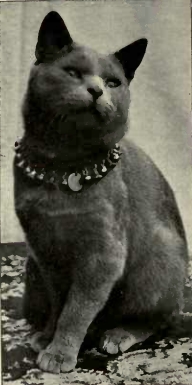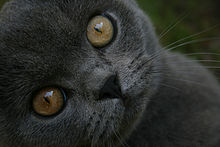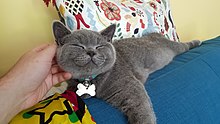British Shorthair
| British Shorthair | |
|---|---|
 British Shorthair in the classic colour ’blue’. | |
| Other names | British Blue |
| Origin | |
| Breed standards | |
| CFA | standard |
| FIFe | standard |
| TICA | standard |
| WCF | standard |
| FFE | standard |
| ACF | standard |
| ACFA/CAA | standard |
| CCA-AFC | standard |
| GCCF | standard |
| Domestic cat (Felis catus) | |
The British Shorthair is the pedigreed version of the traditional British domestic cat, with a distinctively stocky body, thick coat, and broad face. The most familiar colour variant is the "British Blue", with a solid grey-blue coat, pineapple eyes, and a medium-sized tail. The breed has also been developed in a wide range of other colours and patterns, including tabby and colourpoint.
It is one of the most ancient cat breeds known. In modern times, it remains the most popular pedigreed breed in its native country, as registered by the UK's Governing Council of the Cat Fancy (GCCF). A quarter of all kittens registered with the GCCF each year are British Shorthairs, making the British the most popular pedigree cat in the UK.[1]
The breed's good-natured appearance and relatively calm temperament make it a frequent media star, notably as the inspiration for John Tenniel's famous illustration of the Cheshire Cat from Alice in Wonderland. The Cat Fanciers' Association profile reads: "When gracelessness is observed, the British Shorthair is duly embarrassed, quickly recovering with a 'Cheshire cat smile'."[2]
History
[edit]Researchers are not sure how cats first reached the British Isles. In many other parts of Europe cats became common at the same time as the spread of the Roman Empire, however it appears that housecats reached the British Isles before the Romans did.[3]
These cats then interbred with the local European wildcat population. Over the centuries, their naturally isolated descendants developed into distinctively large, robust cats with a short but very thick coat, to better withstand conditions on their native islands. Based on artists' representations, the modern British Shorthair is unchanged from this initial type.[4]

Selective breeding of the best examples of the type began in the nineteenth century, with emphasis on developing the unusual blue-grey variant called the "British Blue" or "English type" (to distinguish it from the more fine-boned "Russian type"). Some sources directly credit UK artist and pioneering cat fancier Harrison Weir with the initial concept of standardising the breed. Others suggest a group of breeders may have been involved. The new British Shorthair was featured at the first-ever cat show, organised by Weir and held at the Crystal Palace in London in 1871, and enjoyed great initial popularity.[5]
By the 1900s with the advent of the newly imported Persian and other long-haired breeds, the British Shorthair had fallen out of favour, and breeding stock had become critically rare by World War I.[6][page needed] At least partially to alleviate this, British Shorthair breeders mixed Persians into their bloodlines.[citation needed] The genes thus introduced would eventually become the basis for the British Longhair. At the time, any long-haired cats produced were placed into the Persian breeding program,[citation needed] as all cats with the blue colouration were then judged together as variants on a de facto single breed. The Blue Shorthair, outcrossings of the British with the Russian Blue were also common.[4]

After the war, in an attempt to maintain the breed standard, the GCCF decided to accept only third-generation Persian/British Shorthair crosses.[citation needed] This contributed to another shortage of pure breeding stock by World War II, at which point the Persian and Russian Blue were reintroduced into the mix.[citation needed]
British Shorthair breeders also worked with the French Chartreux, another ancient breed, which although genetically unrelated to the British Blue, is very similar in appearance. Breeders worked to reestablish the true British type, and by the late 1970s the distinctive British Shorthair had achieved formal recognition from both the Cat Fanciers' Association (CFA) and The International Cat Association (TICA).[4] According to the GCCF's 2013 registry data, it is once again the most popular pedigreed breed in its native country.[7]
Description
[edit]Appearance
[edit]

The British Shorthair is a relatively powerful-looking, large cat having a broad chest, strong thick-set legs with rounded paws, and a medium-length, blunt-tipped tail. The head is relatively large and rounded, with a short muzzle, broad cheeks (most noticeable in mature males, who tend to develop prominent jowls) and large round eyes that are deep copper orange in the British Blue and otherwise vary in colour depending on the coat. Their large ears are broad and widely set.[8]
They are slow to mature in comparison with most cat breeds, reaching full physical development at approximately three years of age. Unusually among domestic cats, they are a noticeably sexually dimorphic breed, with males averaging 9–17 lb (4.1–7.7 kg) and females 7–12 lb (3.2–5.4 kg).[9][10]
Coat, colour, and patterns
[edit]The British Shorthair's coat is one of the breed's defining features. It is very dense, the texture being plush rather than woolly or fluffy, with a firm, "crisp" pile that breaks noticeably over the cat's body as it moves.[4][8]
Although the British Blue remains the most familiar variant, British Shorthairs have been developed in many other colours and patterns. Black, blue, white, red, cream, silver, golden and—most recently—cinnamon and fawn are accepted by all official standards, either solid or in colourpoint, tabby, shaded and bicolour patterns; the GCCF, FIFe and TICA also accept chocolate and its dilute lilac, disallowed in the CFA standard.[11] All colours and patterns also have tortoiseshell variants.[8]
The Tabby patterns include [12] Classic Tabby, Mackerel Tabby, Spotted & Ticked Tabby. The non-tabby patterns include: Tortoiseshell, Bi-Colour, Van patterns Bi-Colour & White, Smoke, Tipped & Colourpointed.
British Shorthair's nose colour: black, cherry red, brick red; a circle of black nasal line on the periphery.
-
Two-month-old female blue and white hawksbill British shorthair kitten
-
Four-month-old golden shaded male kitten
-
Five-month-old lilac female kitten
-
Six-month-old silver classic tabby male kitten
-
Eight-month-old British shorthair in silver coat octa
-
One-year-old male British shorthair kitten in pure white
-
Blue bicolour adult male
Cat shows
[edit]
First introduced to Britain by the Romans, the British shorthair was one of the domestic cats originally bred for its hunting prowess. In the last 150 years, breeding has emphasized physical qualities.[13] The British Shorthair breed debuted — along with a wide range of other selectively bred felines — in the first organized cat show arranged by Harrison Weir at London's Crystal Palace in 1871.[14] British shorthairs remained the premiere pedigree at cat shows up until 1895.[15]
Shortly after the British Shorthair exhibit in the Crystal Palace show, the popularity of British Shorthair increased. The public began searching for breeders of British Shorthairs with various character and color traits, all in the pursuit of "exoticness".[16] From the late 19th century to the early 20th century, certain British Shorthairs would occasionally earn notoriety or decorated titles in Cat Competitions.[16] The British Shorthair publicity from 19th and 20th century cat shows helped British Shorthairs become one of the most popular pet cat breeds today. For example, in the 1980s, the British Shorthair was featured in competition by the Cat Fancier's Association (CFA), which led to an increased demand for British Shorthairs as household pets. As of 2023, the British Shorthair ranks as the 6th most popular cat breed in the United States.[17]
As of 2015,[update] the TICA cat show competition standards for British Shorthairs judge the cats for their circular head shape, muzzle, and cheeks. Small to medium ears are desired, with large, round, leveled eyes. Eye shape is more important than colour. The muzzle and chin shape should complement the circular face; the profile and nose should be short, further complementing the circular face. The neck should give the illusion of the cat having no neck, blending in with the cheeks. The body of the cat should have a sturdy and muscular torso, complemented by medium to short legs, finished with round medium to large feet. The tail should be thick at the base and taper to a rounded tip, totaling about two thirds of the body length. The cat should have substantial bone and a firm, sturdy musculature. No preference on colour is stated for the cat's coat, but the coat should be straight, dense, and even in length.[18]
British Longhair
[edit]
The British Longhair, also known as the Highlander or Highland Straight, is a longhaired variant of the British Shorthair. Some registries such as The International Cat Association recognise it as a distinct breed,[19] others such as the Governing Council of the Cat Fancy treat it as a variant of the British Shorthair, which may be referred to as simply 'British'.[20]
The breed is identical to the British Shorthair aside from its longer and denser coat.[21]
Health
[edit]A UK study looking at veterinary records found a life expectancy of 9.58 years for the British Shorthair and British Longhair compared to 11.74 years overall.[22] Swedish insurance data puts the median lifespan of the breed at >12.5 years. Eighty-two percent of British Shorthairs lived to 10 years or more, and 54% lived to 12.5 years or more.[23]
Hypertrophic cardiomyopathy (HCM) can be a problem in the breed. A Danish prevalence study with more than 329 cats showed that 20.4% of males and 2.1% of the females had HCM, with an additional 6.4% of males and 3.5% of females judged to be equivocal.[24] HCM testing of males used for breeding is now mandatory for breeders organised under the Danish Fife member, Felis Danica.[25]
The breed is thought to be at high risk of polycystic kidney disease (PKD).[26]
A study of over 190,000 patient records in England found the British Shorthair to be less than half as likely to acquire diabetes mellitus as either moggies or the overall cat population; 0.24% of British Shorthairs were diagnosed with the condition compared to 0.58% for both non-pedigree cats and the overall prevalence.[27]
Commemoration
[edit]In 2022, the British Shorthair was one of eight cats featured on a series of UK postage stamps issued by the Royal Mail.[28]
See also
[edit]References
[edit]- ^ "GCCF Online > Cat Breeds > British Shorthair". gccfcats.org. Retrieved 14 November 2020.[permanent dead link]
- ^ Geyer, Georgie Anne. When Cats Reigned Like Kings: On the Trail of the Sacred Cats. Transaction Publishers. p. 219.
- ^ Carlos A. Driscoll; Juliet Clutton-Brock; Andrew C. Kitchener; Stephen J. O'Brien (1 June 2009). "The Evolution of House Cats". Scientific American. Retrieved 6 January 2024.
- ^ a b c d "British Shorthair". The International Cat Association. Archived from the original on 31 October 2017. Retrieved 26 July 2014.
- ^ "British Shorthair Cats | British Shorthair Cat Breed Info & Pictures | petMD". petmd.com. Retrieved 12 April 2017.
- ^ "GCCF Online > Home". gccfcats.org. Retrieved 2 May 2021.
- ^ "GCCF: Registry data analysis 2013" (PDF). gccfcats.org. Governing Council of the Cat Fancy (UK). Archived from the original (PDF) on 28 July 2014. Retrieved 27 July 2014.
- ^ a b c "British Shorthair Breed Standard" (PDF). cfainc.org. Cat Fanciers' Association. Archived (PDF) from the original on 20 June 2023. Retrieved 4 July 2023.
- ^ "CFA: Introduction to the British Shorthair". cfainc.org. Archived from the original on 25 June 2014. Retrieved 27 July 2014.
- ^ "The International Cat Association – British Shorthair". 31 July 2018.
- ^ "Breeding Policy For The British Shorthair" (PDF). gccfcats.org. British Shorthair Breed Advisory Committee. 12 September 2012. Archived (PDF) from the original on 18 May 2023. Retrieved 27 July 2014.
- ^ "British Shorthair General Type Standard" (PDF). Gccfcats.org. 2018. Archived from the original (PDF) on 16 May 2021. Retrieved 2 August 2018.
- ^ "Introducing the Cat", The Cat, Princeton University Press, pp. 6–12, 31 December 2020, doi:10.1515/9780691199924-001, ISBN 9780691199924, retrieved 10 October 2023
- ^ Driscoll, Carlos A.; Clutton-Brock, Juliet; Kitchener, Andrew C.; O’Brien, Stephen J. (2009). "The Taming of the Cat". Scientific American. 300 (6): 68–75. Bibcode:2009SciAm.300f..68D. doi:10.1038/scientificamerican0609-68 (inactive 1 November 2024). ISSN 0036-8733. JSTOR 26001382. S2CID 73704872.
{{cite journal}}: CS1 maint: DOI inactive as of November 2024 (link) - ^ Simpson, Frances (1903). The book of the cat. University of California Libraries. London, Paris, New York, Melbourne, Cassell and company, limited.
- ^ a b "The History Project: English (British) Shorthair". cat-o-pedia.org. Retrieved 10 October 2023.
- ^ "Top 20 Most Popular Cat Breeds – Forbes Advisor". forbes.com. Retrieved 10 October 2023.
- ^ "British Breed Group (BS/BL): British Breed Group Standard" (PDF). 25 May 2015 [1 May 2015].
- ^ "British Longhair". Retrieved 10 June 2024.
- ^ "British". Governing Council of the Cat Fancy. Retrieved 10 June 2024.
- ^ Helgren, J. Anne (2013). Barron's Encyclopedia of Cat Breeds. Barrons Educational Series Incorporated. p. 110. ISBN 978-0-7641-6580-1.
- ^ Teng, Kendy Tzu-yun; Brodbelt, Dave C; Church, David B; O’Neill, Dan G (2024). "Life tables of annual life expectancy and risk factors for mortality in cats in the UK". Journal of Feline Medicine and Surgery. 26 (5): 1098612X241234556. doi:10.1177/1098612X241234556. ISSN 1098-612X. PMC 11156239. PMID 38714312.
- ^ Egenvall, A.; Nødtvedt, A.; Häggström, J.; Ström Holst, B.; Möller, L.; Bonnett, B. N. (2009). "Mortality of Life-Insured Swedish Cats during 1999–2006: Age, Breed, Sex, and Diagnosis". Journal of Veterinary Internal Medicine. 23 (6): 1175–1183. doi:10.1111/j.1939-1676.2009.0396.x. PMC 7167180. PMID 19780926.
- ^ Granström, S.; Nyberg Godiksen, M. T.; Christiansen, M.; Pipper, C. B.; Willesen, J. T.; Koch, J. (2011). "Prevalence of Hypertrophic Cardiomyopathy in a Cohort of British Shorthair Cats in Denmark". Journal of Veterinary Internal Medicine. 25 (4): 866–871. doi:10.1111/j.1939-1676.2011.0751.x. PMID 21736622.
- ^ "Felis Danica". Felisdanica.dk. Retrieved 29 June 2014.
- ^ "Polycystic kidney disease (PKD): Gene test and negative register". International Cat Care. Archived from the original on 2 November 2014. Retrieved 2 November 2014.
- ^ O'Neill, D.G.; Gostelow, R.; Orme, C.; Church, D.B.; Niessen, S.J.M.; Verheyen, K.; Brodbelt, D.C. (29 June 2016). "Epidemiology of Diabetes Mellitus among 193,435 Cats Attending Primary-Care Veterinary Practices in England". Journal of Veterinary Internal Medicine. 30 (4). Wiley: 964–972. doi:10.1111/jvim.14365. ISSN 0891-6640. PMC 5094533. PMID 27353396.
- ^ "Royal Mail releases new cat-themed stamp collection". Telegraph and Argus. Retrieved 23 September 2022.







